On a narrow, low lying strip of coastal country in Northern Europe, scarcely two hundred miles long, a country so water logged that enemies and rivals spoke of it as mud flat, there arose in the seventeenth century one of the great civilizations of the world. The golden age of the Dutch republic stands out as one of the most comprehensive, most astonishing, and most admirable achievements of mankind, a monument alike to human industry and the human spirit.
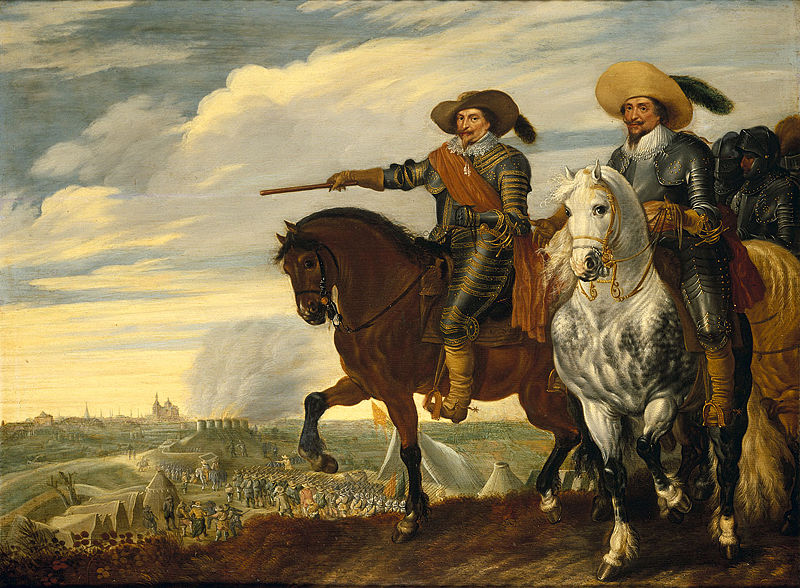
Paulus van Hillegaert. 1630.Prince Frederik Hendrik and Count Ernst Casimir at the siege of 's-Hertogenbosch, 1629.Frederick is riding his favorite grey charger r. and wearing the fine clothes he loved.
From this little country, with its windy sand dunes and its damp pastures, ship went out to sail its farthest seas. On the mud flats large, solid prosperous cities came into being. Their quays received the goods of all the world, which their merchants exchanged and distributed again to all the world. Their great banking houses financed the sovereigns of Europe. Thanks to its geographical position and the enterprise and energy of its people, the Dutch republic was, only teo generations after its founding, the richest commercial community Europe had yet seen.
Such a civilization could have easily been wholly materialist in all its manifestations; a Golden Age in the narrowest and hardest sense. Scientists, thinkers and poets flourished among them. The works of their great painters, luminous, tranquil, and profound, shine out among us still. Spiritual and material greatness were deeply, inextricably interwoven in the great achievement of the Dutch.
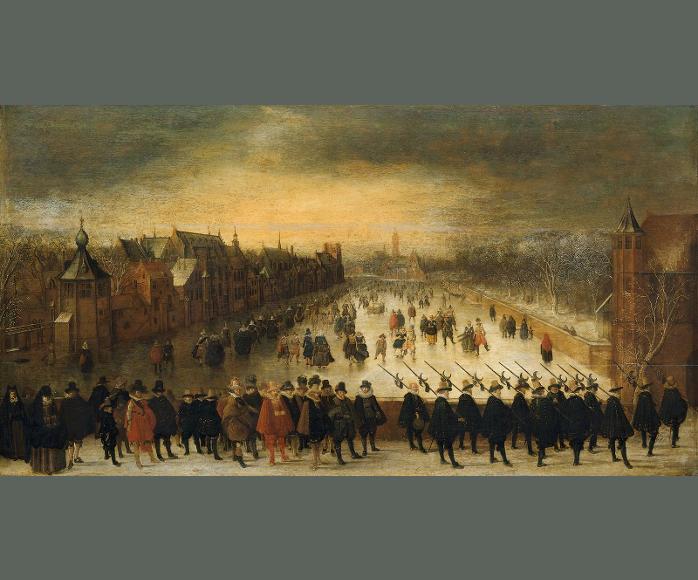
For an afternoon of sport the solid families of The Hague liked to strap on their curly toed skates and glide around the Vijverberg, an artificial pond in the center of town. In this painting by Adam van Breen, Prince maurice of Orange-Nassau and his party have come to watch the fun.
The high noon of the Golden Age is roughly from 1625-1648 during which Frederick Henry, Prince of Orange, guided the affairs of state. Rembrandt was painting and Vondel was composing his great poetic dramas. But the political drama had begun a hundred years earlier, beginning with their assignment to King Philip II of Spain as his cut in the family inheritance as part of the Hapsburg holdings. At that time, the Reformation had shaken and divided Europe and Philip II saw it as his mission to reunite Europe within the fold of the Roman Catholic Church under the dominating influence of Spain.
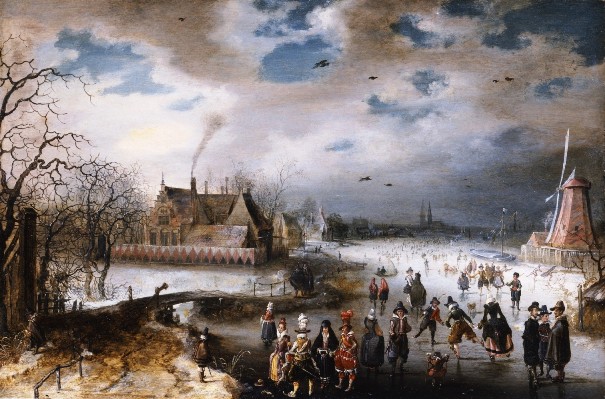
Adam van Breen (ca.1585-1640) Skaters on the Amstel with a View of Amsterdam oil on panel 17 x 25½ in. (43 x 65 cm.) dated 1611
Unfortunately, the Protestant religion in various forms had already penetrated into the Netherlands, and his attempts to stamp it out and meddle in economic policy brought the country to the verge of revolt. In 1567, Philip sent the Duke of Alva to impose military rule on his recalcitrant subjects. But the Dutch, under the Prince of Orange, William of Nassau, organized a rebellion with heroic tenacity and against high odds that resulted with the dislodging of the Spaniards from the northern half of the country. He had hoped to liberate and hold the whole, but after his assassination in 1584 it became clear that the rich southern provinces, which were catholic in sympathy, would remain with Spain, leaving the north to form a new and independent Dutch Republic.
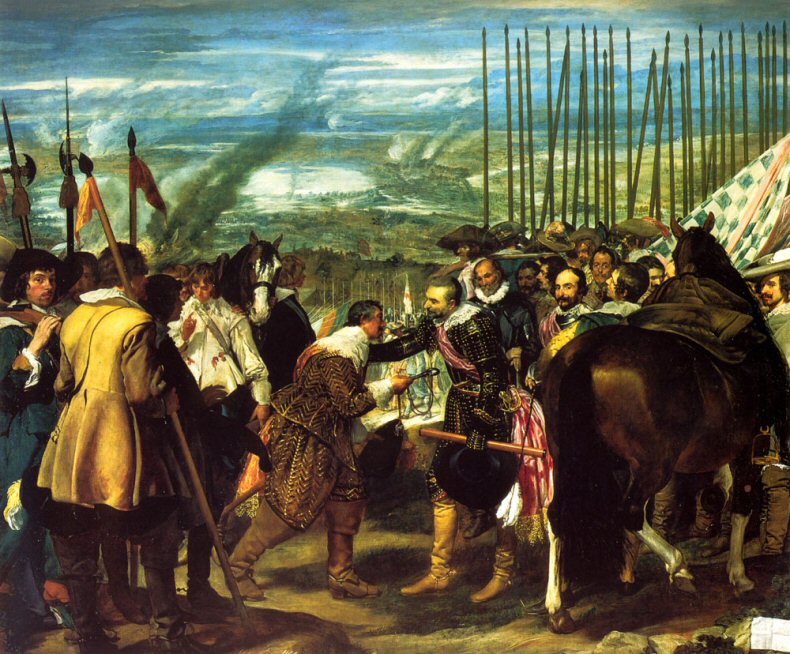
The Srrender of Breda by Velazquez depicts a defeat suffered by Dutch arms in the year the Frederick Henry assumed rule. The glue-green distances of watery Netherlands are seen between the forbidding lances held by Spanish soldiers; in front of them, Spinola, the great Genoese soldier who fought for Spain, leans graciously forward to receive the keys of the town from Justin of nassau, illegitimate son of William the Silent. Because it is so great a historic painting, this work bty the Spanish court painter has made famous an event which was in fact only a local setback in the triumphant rise of the young Dutch Republic.
Frederick Henry did not cause the Golden Age in Holland, but it is impossible to imagine it without his generous and reassuring presence in the background. Under his leadership the Dutch soon re-established equilibrium in the war with Spain and pushed doggedly on to final victory at the Peace of Munster in 1648. During all these years Spain was a visibly declining power , while the young Dutch republic went from strength to strength.
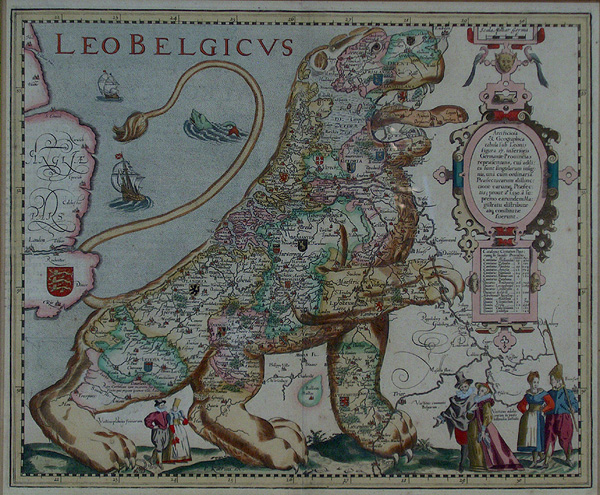
The proud lion of the Netherlands, fighting for its independence from Spain, roars defiance at the Continent, while flicking its tail toward England. This imaginative map of the United Provinces was engraved at Amsterdam 1n 1617 by Pieter van den Keere. In map making, as in politics, it marks a notable Dutch achievement. During the seventeenth century the studios of Hondius, Jansson, Blaeu, and other
Amsterdam turned out, of seamen and merchants, the most decorative maps ever produced.When we think of the Golden Age of the Dutch Republic we think above all of the great painters. The new Dutch middle class wanted homely paintings to decorate the walls of their comfortable rooms. They wanted secular paintings because they were predominantly Protestant, and they valued above all, lifelike representations of their countryside, their domestic life and the objects that gave them pleasure; in addition to portraiture . Dutch portrait painters acquired an extraordinary forcefulness in the treatment of the human face and hands, and an extraordinary skill in working out a striking design with small points of color and relief. Group portraits were also in demand. Paintings became not only a pleasant thing in themselves, but a good speculation and an viable and active art market developed.
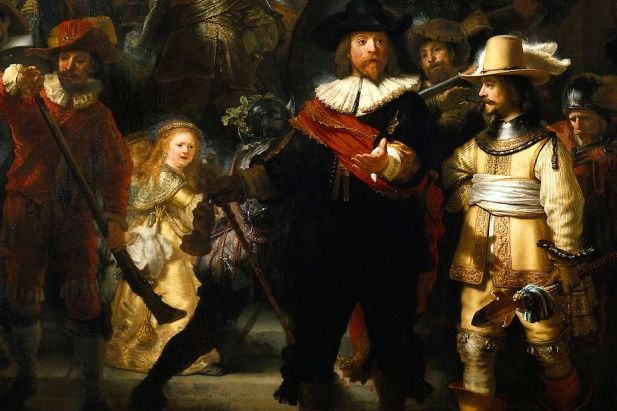
"As portrait painter, in figure pictures of the highest class, and in smaller subjects, both sacred and secular, the Dutch painter Rembrandt is unrivalled. The "Sortie of Banning Cocks Company" is one of those works. For many years the painting was known as the "Night Watch" a more than usually absurd popular name, inasmuch as the scene is in the sunlight. A commission was undertaken by Rembrandt in 1642 to paint Captain Frans Banning Cock and his company of arquebusiers. They ordered and expected to receive a group of portraits in which each man should have full share of light and prominence. Rembrandt painted a picture for all time. The central object is the captain, cane in right hand, left hand extended, engaged in active converse with his lieutenant, Van Ruijtenburg. He is in dark costume, his companion in light. The strong sunlight is shown by the shadow of his hand as it falls upon his comrade. To his right a man loads a gun. In the background are ensigns and pike-men, coming forth from the guard-house, and on the right is a drummer. But how full the painting is of action!"
Rembrandt, however, gave offense by breaking the rules of convention. Carried away by his own more profound and subtle vision of the play of light and shade, he painted in “The Sortie of the Banning Cocq Company” , one of the greatest of his pictures and certainly them most memorable of all the group portraits of this epoch. But it is easy to understand why some of the sitters, whose forms and faces are lost in shadow, were far from pleased with the result.
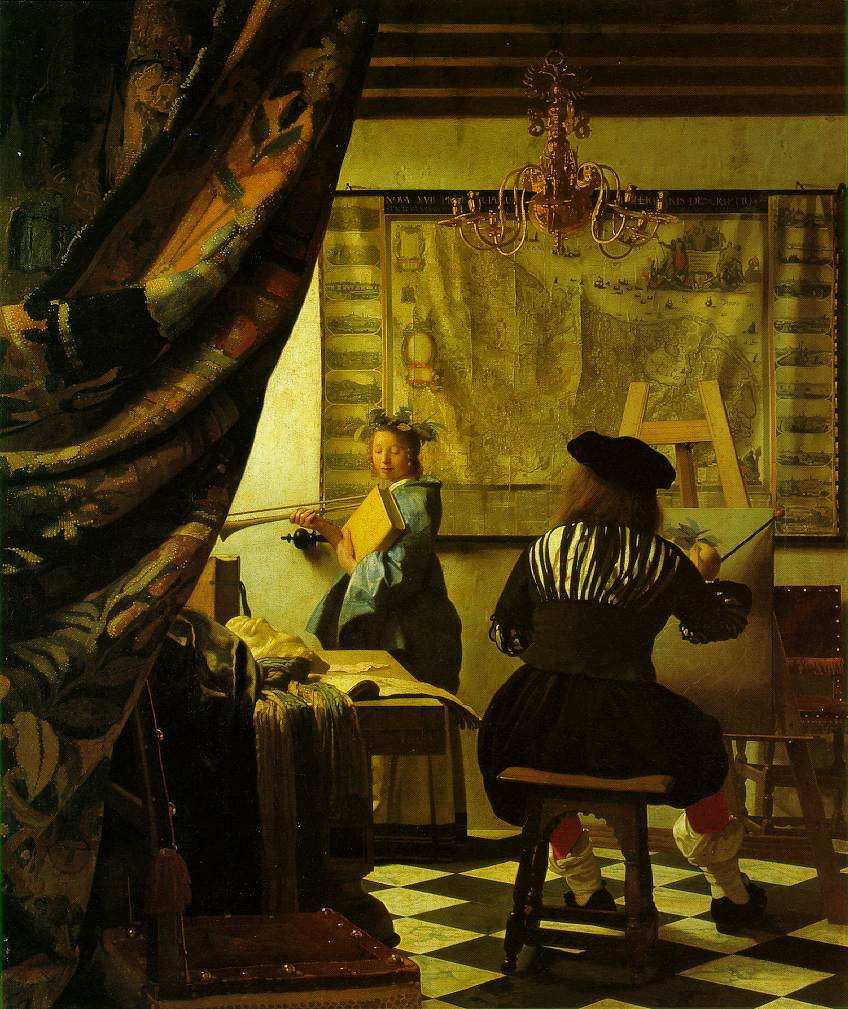
Jan Vermeer was a true genius. "The Artist in his Studio" shows vermeer himself at work in the room where he executed almost all, less than forty, of his works. Vermeer's widow gave this painting to her mother, and in passing through various hands it lost its identity. By 1915, Vermeer's fame had risen to such a level that Andrew Mellon supposedly bid $2,000,000 for it. Adolf Hitler got it for a while and hung it in his mountain chalet at Berchtesgaden. When the U.S. Third Army overran Austria in 1945 it found the painting hidden with the nazi art treasure in a salt mine in the mountains above Salzburg. Patton then handed it over to the state art museum at Vienna.
Rembrandt was for a time a fashionable and successful portrait painter, but he stands apart from the portrait painters and genre painters who supplied the new and eager demands of the Dutch. He has the quality of genius which is outside historic time and place. However, Rembrandt could have achieved the fulfillment of his genius nowhere else so well as in seventeenth-century Holland. Amsterdam with its world wide trade provided him with exciting and infinite visual material; his book was life, and he read people and learned in the end to set down what he had read with a sad and silent wisdom that has never been equalled.
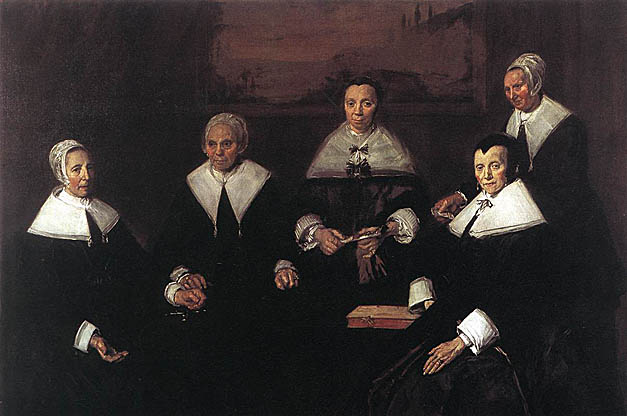
"The two large format group portraits of the Regents and Regentesses of the Old Men's Almshouse in Haarlem are not only one of the last major work by this artist who ranks beside Rembrandt as the greatest of all portrait painters, they are also the last historically significant examples of this genre. Whereas Hals previously presented individual gestures, attitudes and poses in a ceremonial and more than momentary context, here he isolates the individual parts and the individuals themselves. The faces above the white collars seem to float against the dark ground of a room that is difficult to distinguish. The "breakdown" of the figurative corresponds to the brushwork whose ductus is no longer fluid, but broken so that it seems to crumble into particles of color. Here and there, a shimmer of red flares up through the black like the final glimmer of dying embers in the ashes. Frans hals. painter of youth and merriment, was brought to bankruptcy by the baker from whom he borrowed to feed his ten children. The city paid his rent, and his last commission came from the ladies who appear in this gray and somber portrait
For a time he was successful, but genius so individual and so strong can rarely retain popular favor. He went beyond his public and fell into disfavor. But he was never utterly neglected. He always retained a small group of discriminating admirers and of patrons who valued and bought his pictures. It is the great merit of a society like that of seventeenth-century Holland, so competitive and so various, that it has room for small groups, literary and artistic cliques, which can sustain and encourage work outside the grasp of the general public.

The Blue Girl by Cornelisz Verspronck was just ghe painting to appeal to a fond parental eye. The family loving Dutch adored, indulged, and, in the opinion of foreigners, thoroughly spoiled their children. Visitors from France were scandalized to find the rosy Dutch youngsters talking back to their parents.
It would not be strictly true to say that Rembrandt reveals the inner spirit of the Dutch at this time. He is a painter of the spirit, but his message is at the same time so individual and so universal that it would be a belittlement to attach it merely to the Dutch Golden Age. But no epoch, however fruitful can be held to be truly great unless it has produced one giant of universal stature, one genius who transcends time and place. For the Golden Age of the Dutch Republic that giant is Rembrandt.
One other painter of this time has a claim to rank among the greatest; a painter whose achievement, unlike that of Rembrandt, belongs in time and space and by every outward convention to Holland in the seventeenth century and to no other epoch or place in the world. That painter is jan Vermeer of Delft. He depicted with absolute faithfulness the domestic scenes and simple views that were so dear to Dutch collectors. It is a world of the mundane. But it is also, and who can say why?, a moment stopped out of time. Here is an incident of no importance, a fragment from the lives of unknown people held forever, not just as a picture but as a reality. With the other Dutch genre painters we know we are looking at a picture; with Jan Vermeer we are experiencing a living moment.
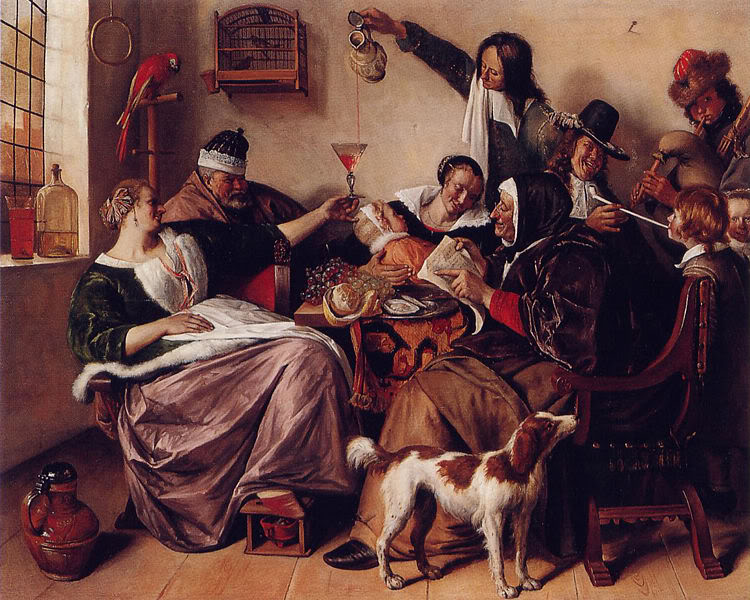
Jan Steen."Steen's picture is full of humour. The proverbial piping, for example, is portrayed literally: in imitation of their parents, one child smokes a pipe and the other plays the bagpipes. The near-sighted grandmother sings from a sheet of music, the mother is having her glass refilled, and the grandfather watches the entire proceedings with obvious amusement. What makes it even funnier is that Steen, with a healthy dose of self-mockery, used his own family as models. Steen himself is the laughing man holding the pipe, the voluptuous woman on the left is his wife, Grietje van Goyen, and the children are recognisable as their own offspring. "
With him therefore, we come nearest to the inner essence of the Dutch seventeenth century. The zest for liberation, the adventurousness,the energy and the wealth of this remarkable people do not explain all. What else must there have been? Does the secret lie in this intensity of living, this concentration of the spirit, which Vermeer has so perfectly and so indefinably captured within the narrow limits of his few surviving paintings?
a





 COMMENTS
COMMENTS